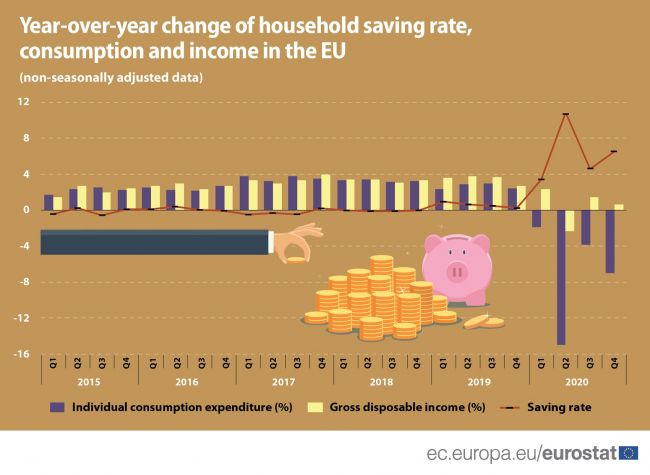Impact of Covid-19 crisis on non-financial corporation and household accounts
Data extracted in May 2021.
No planned update for this article.
Highlights
Household saving rate (non-seasonally adjusted) increases to 20.0 % in the euro area and 19.0 % in the EU. Household investment rate remains stable
Slight increase of business investment rate (non-seasonally adjusted) to 24.1% in the euro area and 24.5% in the EU
This article provides a short analysis of key macroeconomic indicators of two institutional sectors of the economy: households and non-financial corporations. Its goal is to show the impact of the COVID-19 crisis on the European aggregates and the trends across countries during the fourth quarter of 2020, when the lockdown measures continued.
The article will initially analyse household gross saving and investment rates, gross disposable income and their components at European and national level. Afterwards, it will focus on non-financial corporation gross profit share, gross business investment rate, gross operating surplus and their components.
Finally, it will underline how the COVID-19 lockdown has affected the collection, compilation and dissemination of quarterly sector accounts data.
Full article
Household gross disposable income, saving and investment rates
Household saving rate (non-seasonally adjusted) increases to 20.0 % in the euro area and 19.0 % in the EU due to the drop of household consumption expenditure
The household saving rate at EU and euro area level continued with a large year-over-year increase (2020Q4 vs 2019Q4, non-seasonally adjusted data), at +6.6 and +7.1 percentage points (pp) respectively. The main reason is the large year-over-year decrease of household final consumption expenditure (-7.0 % in the EU and -7.5 % in the euro area), in stark contrast with its increases above 2 % in the previous years.
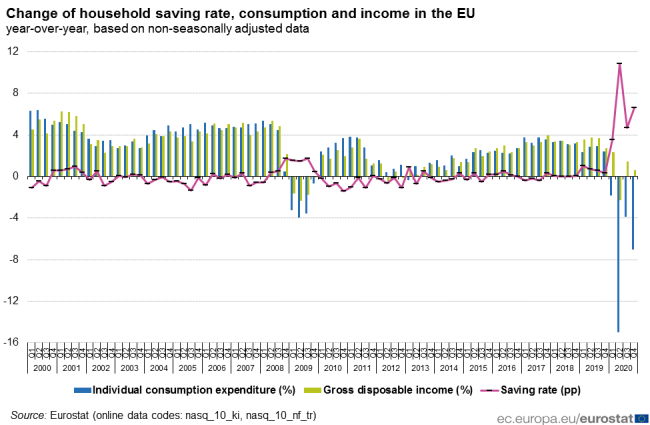
Source: Eurostat (nasq_10_ki,nasq_10_nf_tr)
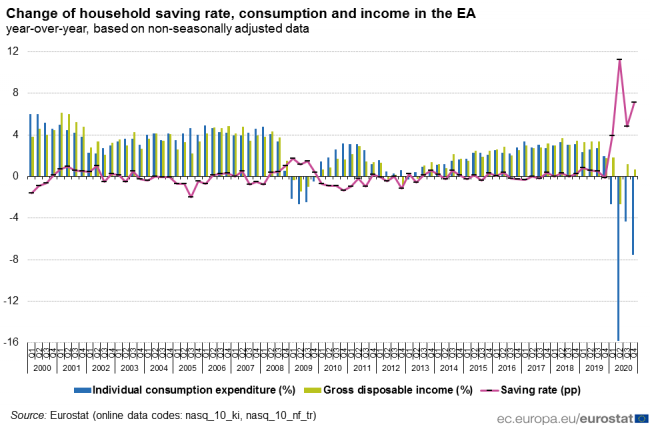
Source: Eurostat (nasq_10_ki,nasq_10_nf_tr)
The household saving rate has increased in all but one of the Member States for which data are available at the moment of writing this paper for the fourth quarter of 2020. The highest year-over-year increase is observed for Slovenia (+20.8 pp), followed by Ireland (+12.8 pp). On the other hand, the household saving rate decreased in Denmark (by -2.7 pp). In the thirteen remaining countries, it increased from +4 pp to +12 pp.
The increase in the household saving rate in the majority of the countries with available data is mainly explained by the large decrease in year-over-year household individual consumption expenditure. The largest decreases in household consumption were observed for Slovenia and Spain (-15.4 % and -11.2 % respectively). Denmark was the only country where household consumption increased (by +0.2 %).
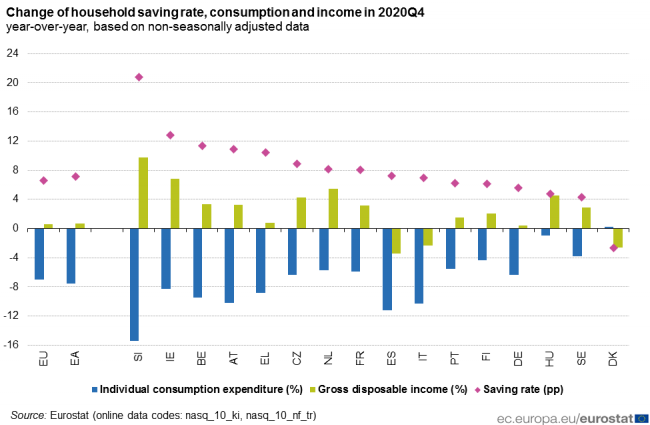
Source: Eurostat (nasq_10_ki,nasq_10_nf_tr)
Household investment rate recovers in both the euro area and the EU
The household investment rate increased slightly year-over-year by +0.2 pp in the EU and +0.2 pp in the euro area, in contrast with its large decrease in 2020Q2. This decrease is explained by the year-over-year increase in household gross fixed capital formation (+3.0 % in the EU and +2.2 % in the euro area), higher than the year-over-year increase in gross disposable income of households (+0.6 % in the EU and +0.7 % in the euro area).

Source: Eurostat (nasq_10_ki,nasq_10_nf_tr)
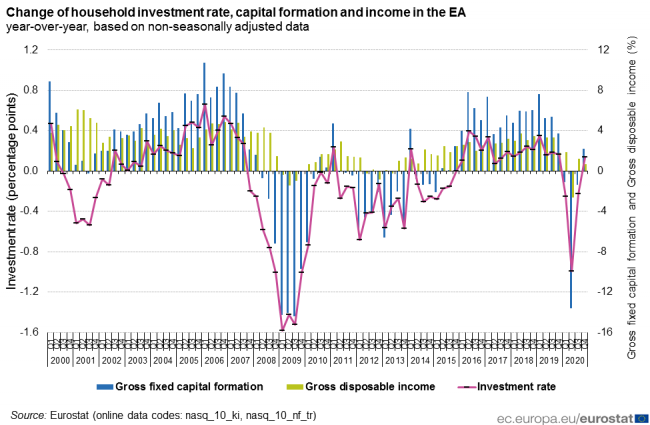
Source: Eurostat (nasq_10_ki,nasq_10_nf_tr)
The year-over-year change of the household investment rate varied among Member States for which data are available for the fourth quarter of 2020, with ten Member States recording an increase and five recording a decrease. The largest increase in the household investment rate was observed for Hungary (+2.0 pp), followed by Denmark (+1.1 pp), due to the appreciable increase in gross fixed capital formation of households (+21.6 % and +9.1 % respectively). On the other hand, Czechia and Finland recorded the largest decreases (-1.6 pp and -0.8 pp respectively), due to their important decreases in gross fixed capital formation (-11.4 % and -4.8 % respectively).
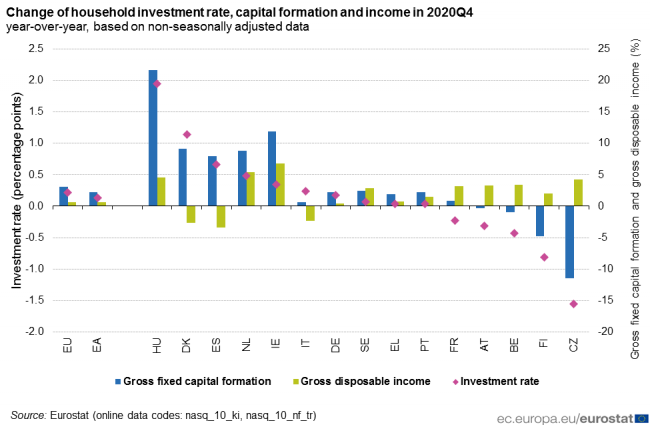
Source: Eurostat (nasq_10_ki,nasq_10_nf_tr)
Household gross disposable income remains in year-over-year increase due to social benefits
Household disposable income in the UE and the euro area increased year-over-year in 2020Q4 (+0.6 % and +0.7 % respectively), in contrast with 2020Q2 when it had a year-over-year decrease. As in the two previous quarters, the contributions to that growth (both the positive and negative ones) were very different to the 2011-2020 period. Social benefits (other than social transfers in kind) provided the largest positive contribution (+2.5 pp and +2.6 pp respectively). On the other hand, property income was the largest negative contributor (-0.9 pp and -1.0 pp respectively).
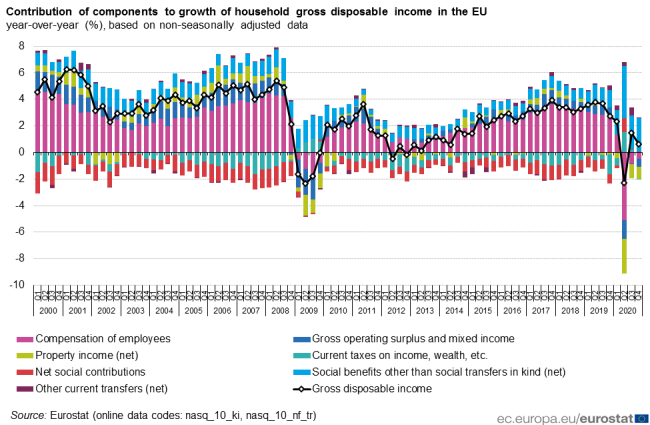
Source: Eurostat (nasq_10_ki,nasq_10_nf_tr)
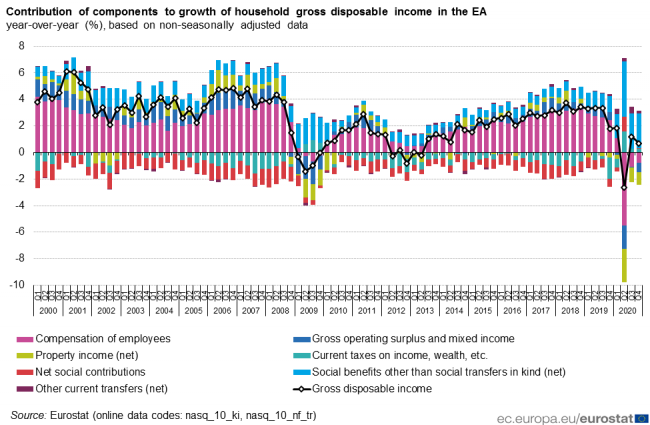
Source: Eurostat (nasq_10_ki,nasq_10_nf_tr)
In 2020Q4, Gross disposable income of households increased year-over-year in thirteen of the countries for which data was available, while decreased in three. The largest increases were recorded in Slovenia (+9.8%) and Ireland (+6.8%). The three countries with year-on-year decreases were Spain (-3.4%), Denmark (-2.6%) and Italy (-2.4%). In all the countries the contribution of social benefits was positive and among the largest ones. The main contributor to the decrease in Spain and Italy was compensation of employees, while in Denmark, it was other current transfers, taxes on income, wealth, etc.
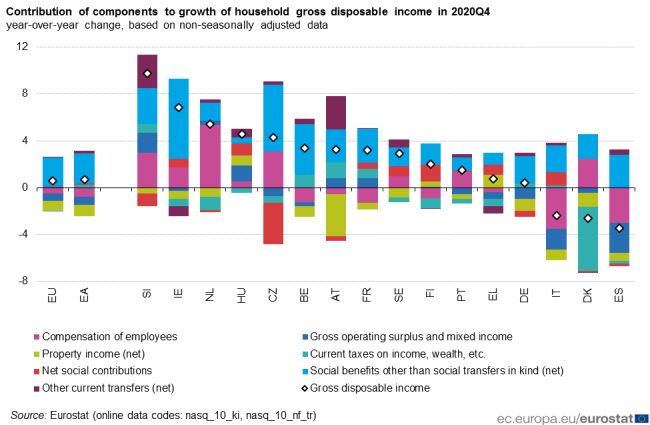
Source: Eurostat (nasq_10_ki,nasq_10_nf_tr)
Business profit share increases
Both the EU and the euro area experienced a year-on-year increase in profit share in 2020Q4 (by +0.5 pp and +0.6 pp respectively), in contrast with the y o-y decreases of the first three quarters of the year. The reason was that, even when gross value added decreased (by -3.6 % and -4.1 % respectively), compensation of employees decreased as well (by -2.1 % and -2.5 % respectively), while other subsidies on production hugely increased y-o-y (by +65.1 % and +70.1 % respectively).

Source: Eurostat (nasq_10_ki,nasq_10_nf_tr)
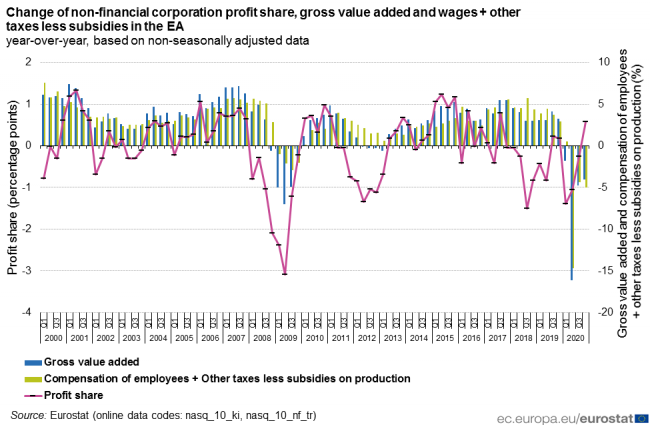
Source: Eurostat (nasq_10_ki,nasq_10_nf_tr)
Nine Member States, for which data are available, observed an increase in non-financial corporation profit share in 2020Q4 compared with 2019Q4, while eight other countries observed a decrease. The largest increase was observed in Austria (+7.0 pp), followed by the Netherlands (+3.3 pp). In both cases, the main reason was the large increase of other subsidies on production. On the other hand, the largest year-over-year decreases were observed in Greece (-3.7 %), Portugal and Estonia (both at -2.0%), being the main reason their decrease of gross value added.
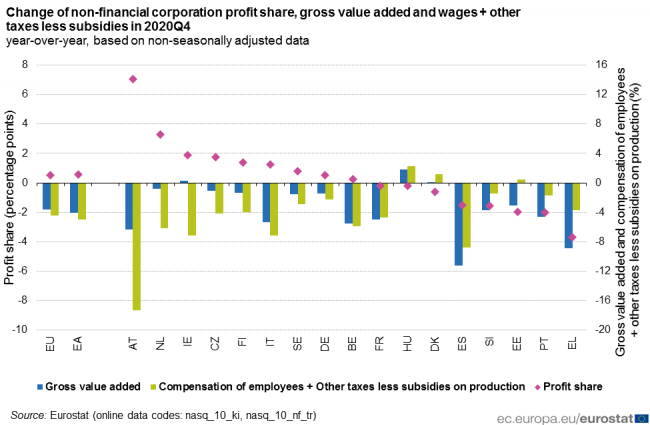
Source: Eurostat (nasq_10_ki,nasq_10_nf_tr)
Non-financial corporation investment rate decreases
The business investment rate of non-financial corporations decreased year-on-year in the EU (-2.2 pp) and the euro area (-2.0 pp), due to the large decrease in gross fixed capital formation in most countries, especially in Ireland (due to large imports of intellectual property products reflecting globalisation effects in 2019Q4, the reference quarter). Excluding that country, the investment rate would have remained stable in the EU and the euro area, since both the gross value added and gross fixed capital formation would have decreased at a similar rate (around -4 % y-o-y).
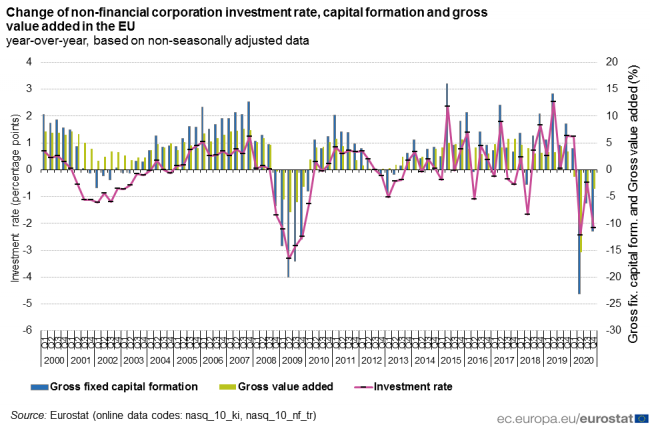
Source: Eurostat (nasq_10_ki,nasq_10_nf_tr)
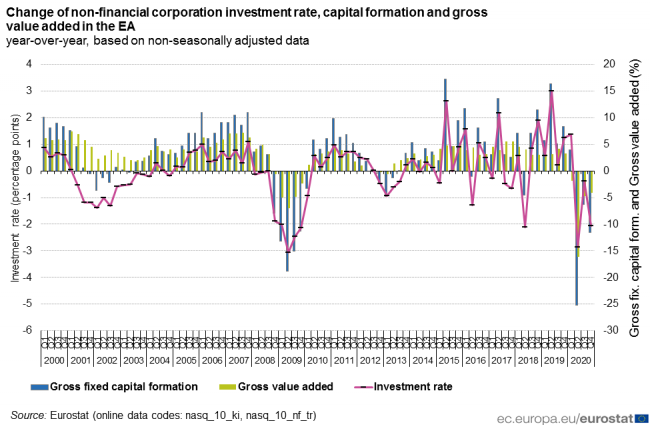
Source: Eurostat (nasq_10_ki,nasq_10_nf_tr)
Eight Member States, for which data are available, recorded an increase in the investment rate of non-financial corporations in 2020Q4 compared with 2019Q4. The largest increase was observed in Estonia (+28.3 pp), due to the very large increase in non-financial corporation gross fixed capital formation (+106.0 %). On the other hand, the largest decrease was observed in Ireland (-52.2 pp), explained by the large drop in gross fixed capital (-61.9 % year-over-year).
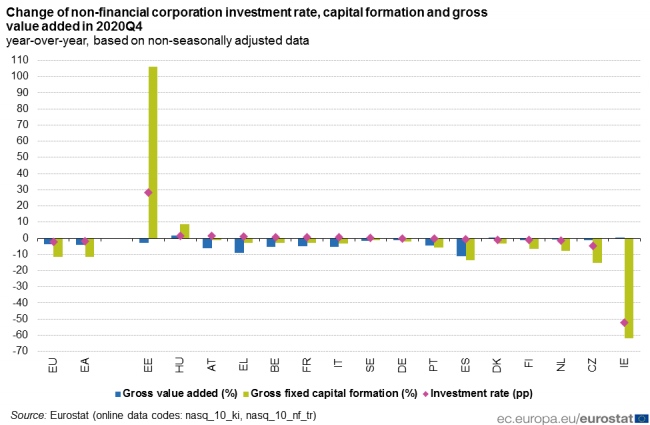
Source: Eurostat (nasq_10_ki,nasq_10_nf_tr)
Gross operating surplus of non-financial corporations still on year-over-year decrease due to the decrease of gross value added
In 2020Q4, non-financial corporation gross operating surplus still had a year-over-year decrease in the EU (-2.3 %) and the euro area (-2.6 %), though at a lower negative rate than in previous quarters. The main reason was the negative contribution of gross value added (normally positive). Conversely, both compensation of employees (whose contribution is normally negative) and other subsidies on production contributed positively, as in the three previous quarters, but still they did not compensate fully for the loss in gross value added.
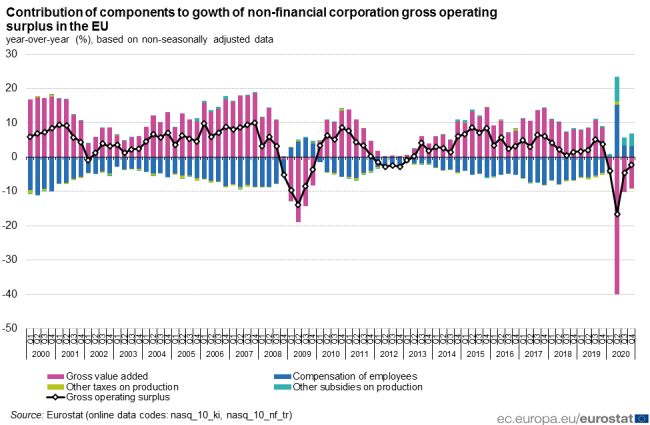
Source: Eurostat (nasq_10_ki,nasq_10_nf_tr)
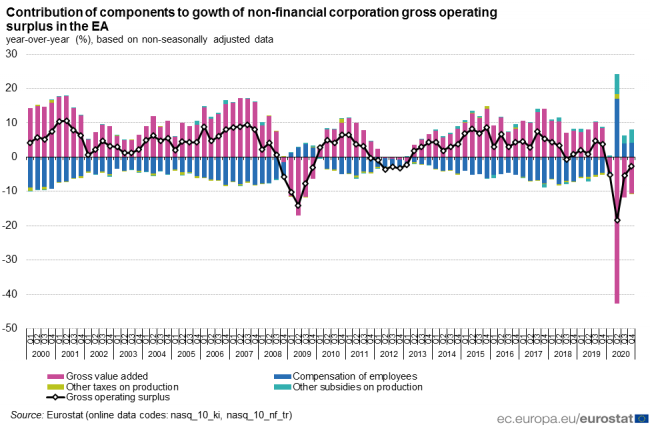
Source: Eurostat (nasq_10_ki,nasq_10_nf_tr)
Nine Member States for which data are available recorded an increase in gross operating surplus of non-financial corporations in 2020Q4 compared with 2019Q4. Austria (+10.2 %) and the Netherlands (+7.5%) had the largest increases, with the enormous increase in other subsidies on production being the main reason. On the other hand, ten Member States recorded a decrease in gross operating surplus of non-financial corporations on a year-by-year basis, the highest being in Greece (-18.8%) and Spain (-14.2%), being the main reason the negative contribution of gross value added.
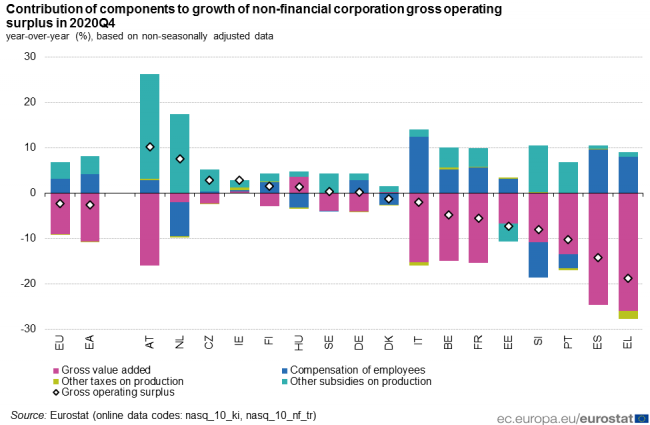
Source: Eurostat (nasq_10_ki,nasq_10_nf_tr)
Impact of COVID-19 lockdown on the collection, compilation and dissemination of quarterly sector accounts data
Since the beginning of the COVID-19 outbreak, Eurostat has been in close cooperation with National Statistical Institutes (NSIs) to ensure the timeliness and quality of quarterly sector accounts (QSA). The publication of QSA data for the reference period 2019Q4 in April 2020 was already impacted by the lockdown in the majority of Member States, even though the impact was mostly due to organisational aspects (many NSIs had to change their working arrangements) rather than due to source data availability and changes in compilation methods.
Based on the discussions of possible issues and solutions with NSIs, Eurostat released first guidance notes on COVID-19 related compilation processes. This included two notes on QSA compilationand transmissionaspects.
As part of the data transmission of QSA data for the reference period 2020Q1-2020Q4, NSIs sent to Eurostat supplementary information on the availability of data sources and possible adaptations in sources and methods related to data compilation for 2020Q1-2020Q4. The main observations are:
- The majority of Member States had put in place government schemes to support enterprises and households by the end of March 2020. They had limited impact on 2020Q1 for the majority of Member States, a larger impact in 2020Q2 and the majority of the government schemes were also in place in 2020Q3 and 2020Q4.
- The vast majority of NSIs had access to their regular data sources and were able to use their standard estimation methods, even if for seasonal adjustment there was a need to make adjustments for outliers in the latest quarter of some time-series, according to Eurostat’s guidelines. In certain cases, the data availability for some variables was lower and estimation methods had to be adapted accordingly.
- For certain variables (e.g. taxes and social contributions), also related to support schemes put in place by Member States, it is expected that subsequent routine revisions may be higher than usual.
- Based on the above, for the majority of Member States, the QSA results for 2020Q1-2020Q4 are of the same quality as usual. However, for certain Member States, the availability of data sources had an adverse impact on the overall quality of QSA statistics.
Data sources
The compilation of the European sector accounts follows the European System of Accounts 2010 (ESA 2010) and covers the period from the first quarter of 1999 onwards.
Institutional sectors bring together economic units with broadly similar characteristics and behaviour, namely: households (including non-profit institutions serving households), non-financial corporations, financial corporations, government and the rest of the world. In the latter, to measure the external transactions of the euro area / EU, it is necessary to remove cross-border flows within the area concerned.
In line with their institutional competences, Eurostat and the European Central Bank (ECB) publish integrated non-financial and financial accounts for the euro area. Eurostat also publishes the non-financial accounts of the European Union.
Eurostat's website presents sector accounts by country and derived key indicators, which also include the indicators that combine non-financial and financial accounts such as debt-to-income ratios. The full set of quarterly sector accounts is published for euro area / EU aggregates. Quarterly sector accounts data are also available for most of the European Economic Area (EEA) Member States in the Eurostat database, and a subset of quarterly key indicators is published around 102 days after each quarter. The EEA members whose GDP is below 1 % of the EU total do not have to transmit the quarterly accounts of households to Eurostat.
- The European Union (EU) consists of 27 Member States: Belgium, Bulgaria, Czechia, Denmark, Germany, Estonia, Ireland, Greece, Spain, France, Croatia, Italy, Cyprus, Latvia, Lithuania, Luxembourg, Hungary, Malta, the Netherlands, Austria, Poland, Portugal, Romania, Slovenia, Slovakia, Finland and Sweden plus the EU institutions.
- The euro area (EA) consists of 19 Member States: Belgium, Germany, Estonia, Ireland, Greece, Spain, France, Italy, Cyprus, Latvia, Lithuania, Luxembourg, Malta, the Netherlands, Austria, Portugal, Slovenia, Slovakia and Finland, plus the European Central Bank, the European Stability Mechanism and the European Financial Stability Facility.
Direct access to
- National accounts, see:
- National accounts (ESA 2010) (na10)
- Quarterly sector accounts (ESA 2010) (nasq_10)
- Key indicators (nasq_10_ki)
- Non-financial transactions (nasq_10_nf_tr)
- Quarterly sector accounts (ESA 2010) (nasq_10)
- Institutional sector accounts — concepts
- European system of accounts — ESA 2010
- Non-financial transactions (ESMS metadata file — nasa_10_nf_tr_esms)
Legislation
- Regulation (EU) No 0549/2013 of the European Parliament and of the Council of 21 May 2013 on the European system of national and regional accounts in the European Union.
